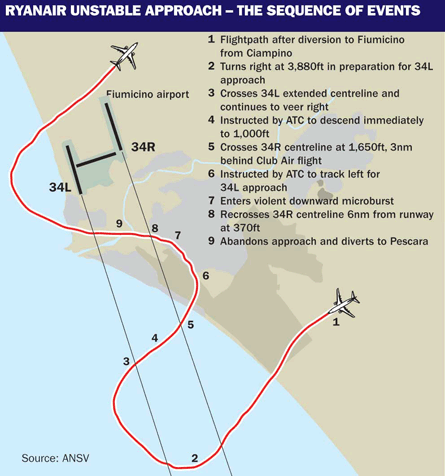Investigators believe a newly bereaved Ryanair captain's psychological state, combined with his co-pilot's inexperience, led to an unplanned and highly unstable approach to Rome during poor weather conditions.
Italy's ANSV investigation agency says the captain's three-month-old son had died just a few days before the Niederrhein-Rome Ciampino flight, but he had not informed anyone of the situation, partly out of concern for his job.
The ANSV, which has just released details of the September 2005 incident, adds that the co-pilot of the Boeing 737-800 - who had just 300h on type from 475h total - had not previously flown in adverse weather conditions.
The crew had already been forced to weave a path around storms during a prolonged attempt to land at Ciampino. But instead of diverting to its alternate, Pescara, the crew opted for an unplanned diversion to Rome Fiumicino.
 |
|---|
The investigation agency says the crew failed to brief properly for this, and did not update the flight management system during the turbulent conditions, resulting in the pilots' rapidly losing position awareness.
While south of Fiumicino and being flown manually, the jet started turning right at 3,880ft (1,180m) in preparation for the 34L approach. It crossed the extended 34L centreline, but continued to veer to the right, crossing the centreline of 34L again.
The ANSV says the co-pilot failed to switch radio frequency to Fiumicino approach and instead requested descent to 2,000ft. As the aircraft was heading for the parallel 34R approach path, controllers ordered an immediate descent to 1,000ft because this approach was in use by a Club Air flight.
The 737 crossed the 34R centreline at 1,650ft, about 5km (3nm) behind the Club Air flight, and controllers instructed the Ryanair crew track left and realign with the 34L approach.
But the crew was not informed that they were flying too low - 770ft below the correct profile of 2,200ft - and the situation deteriorated as the aircraft, according to the captain, entered a violent downward microburst. The 737 recrossed the 34R extended centreline, while still about 11km south of the runway, at just 370ft before finally abandoning the approach and diverting to Pescara.
 |
|---|
It landed with 1,250kg (2,750lb) of fuel, from an initial upload of 8,200kg that covered the flight minimum, plus 950kg for contingency.
The ANSV says the unplanned diversion left the crew "without a definite strategy" and a "largely absent" decision-making process. Loss of situational awareness meant the captain, already in a poor psychological state, was forced to concentrate solely on flying the aircraft, with the co-pilot able to provide only limited support - although the ANSV credits the co-pilot with prompting the final decision to abort.
Issues about access to timely weather information and the need for better minimum safe altitude warnings, as well as the possibility of fatigue, are also highlighted by the investigation.
Ryanair changed its operations manual following the incident to emphasise the flight safety implications of personal trauma, and the importance of notification to flight operations management.
Source: Flight International



















